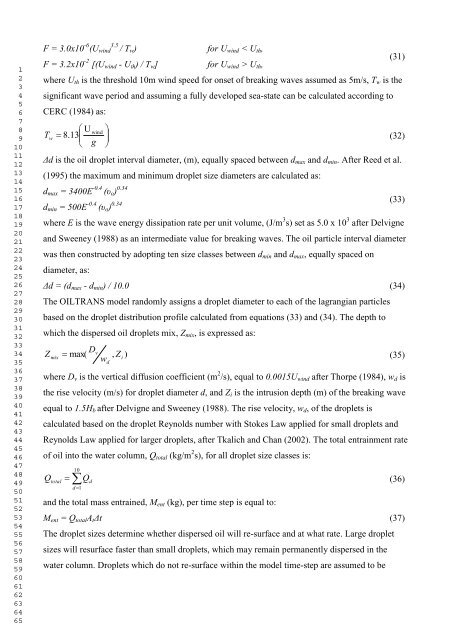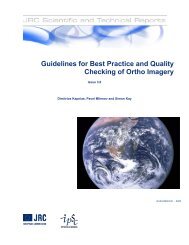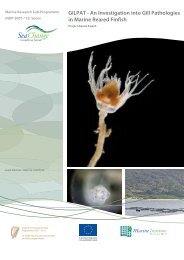The oil spill model OILTRANS and its application to the Celtic Sea ...
The oil spill model OILTRANS and its application to the Celtic Sea ...
The oil spill model OILTRANS and its application to the Celtic Sea ...
Create successful ePaper yourself
Turn your PDF publications into a flip-book with our unique Google optimized e-Paper software.
1234567891011121314151617181920212223242526272829303132333435363738394041424344454647484950515253545556575859606162636465F = 3.0x10 -6 3.5(U wind / T w ) for U wind < U th ,(31)F = 3.2x10 -2 [(U wind - U th ) / T w ] for U wind > U th ,where U th is <strong>the</strong> threshold 10m wind speed for onset of breaking waves assumed as 5m/s, T w is <strong>the</strong>significant wave period <strong>and</strong> assuming a fully developed sea-state can be calculated according <strong>to</strong>CERC (1984) as:T w Uwind 8 .13(32) g Δd is <strong>the</strong> <strong>oil</strong> droplet interval diameter, (m), equally spaced between d max <strong>and</strong> d min . After Reed et al.(1995) <strong>the</strong> maximum <strong>and</strong> minimum droplet size diameters are calculated as:d max = 3400E -0.4 (υ o ) 0.34(33)d min = 500E -0.4 (υ o ) 0.34where E is <strong>the</strong> wave energy dissipation rate per unit volume, (J/m 3 s) set as 5.0 x 10 3 after Delvigne<strong>and</strong> Sweeney (1988) as an intermediate value for breaking waves. <strong>The</strong> <strong>oil</strong> particle interval diameterwas <strong>the</strong>n constructed by adopting ten size classes between d min <strong>and</strong> d max , equally spaced ondiameter, as:Δd = (d max - d min ) / 10.0 (34)<strong>The</strong> <strong>OILTRANS</strong> <strong>model</strong> r<strong>and</strong>omly assigns a droplet diameter <strong>to</strong> each of <strong>the</strong> lagrangian particlesbased on <strong>the</strong> droplet distribution profile calculated from equations (33) <strong>and</strong> (34). <strong>The</strong> depth <strong>to</strong>which <strong>the</strong> dispersed <strong>oil</strong> droplets mix, Z mix , is expressed as:DZ max(vmix , Zi)w(35)dwhere D v is <strong>the</strong> vertical diffusion coefficient (m 2 /s), equal <strong>to</strong> 0.0015U wind after Thorpe (1984), w d is<strong>the</strong> rise velocity (m/s) for droplet diameter d, <strong>and</strong> Z i is <strong>the</strong> intrusion depth (m) of <strong>the</strong> breaking waveequal <strong>to</strong> 1.5H b after Delvigne <strong>and</strong> Sweeney (1988). <strong>The</strong> rise velocity, w d , of <strong>the</strong> droplets iscalculated based on <strong>the</strong> droplet Reynolds number with S<strong>to</strong>kes Law applied for small droplets <strong>and</strong>Reynolds Law applied for larger droplets, after Tkalich <strong>and</strong> Chan (2002). <strong>The</strong> <strong>to</strong>tal entrainment rateof <strong>oil</strong> in<strong>to</strong> <strong>the</strong> water column, Q <strong>to</strong>tal (kg/m 2 s), for all droplet size classes is:10Q (36)<strong>to</strong>talQ dd 1<strong>and</strong> <strong>the</strong> <strong>to</strong>tal mass entrained, M ent (kg), per time step is equal <strong>to</strong>:M ent = Q <strong>to</strong>tal A t Δt (37)<strong>The</strong> droplet sizes determine whe<strong>the</strong>r dispersed <strong>oil</strong> will re-surface <strong>and</strong> at what rate. Large dropletsizes will resurface faster than small droplets, which may remain permanently dispersed in <strong>the</strong>water column. Droplets which do not re-surface within <strong>the</strong> <strong>model</strong> time-step are assumed <strong>to</strong> be
















